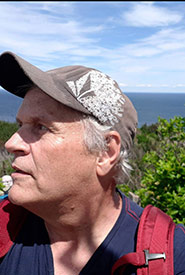Plugs for the prairies
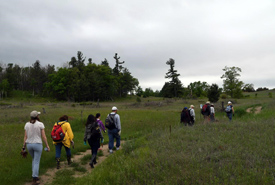
Team hike to the planting area (Photo by Robert Britton)
Since I was a child, I was fascinated by the way a seed could spring to life inside moist soil. I remember faithfully planting seeds in my mini-greenhouse and marveling at the miracle unfolding before me. This fascination carried on for me in adulthood, although I now have just a tiny plot of land beside my urban house. You can find me faithfully planting tiny seedlings in front of my house every spring, while my neighbours plant their glorious greenhouse products.
On May 31, I had the opportunity to take my seedling-planting expertise to help on a much grander scale in the oak savannah area just south of Rice Lake Plains, near Roseneath. It was on a 290-acre (117-hectare) property owned by the Nature Conservancy of Canada (NCC).
The property is called Hazel Bird Nature Reserve. I had assumed that “Hazel” was the name and birds were the tenants. In fact, it actually refers to a woman of that name who once dedicated herself to improving bluebird habitat in the area by erecting hundreds of birdhouses for them.
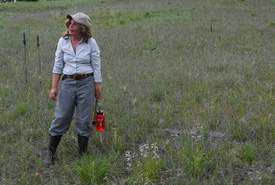
Val Deziel patiently answering questions (Photo by Robert Britton)
NCC’s Val Deziel ably and informatively led the way and instructed us on how to plant tall grass prairie plugs. Her passion and knowledge perfectly match the goal of tall grass prairie restoration at Hazel Bird Nature Reserve. A large group of us set out and planted thousands of seedlings that day in two parts of the prairies. It is not the first seeding: these have been done several times to gradually push out invasive knapweed from the area. The fruits of the past are visible, but much more work lies ahead. The same is true of the trees around the meadows. Many, such as Scotch pine, are being weeded out to improve the lot of the forests.
You may wonder what we were planting. Well, it seemed to me to be a dozen or so different plants that belong there. These included hairy beardtongue, big blue, Indian grass, butterfly milkweed and a few young white oak trees.
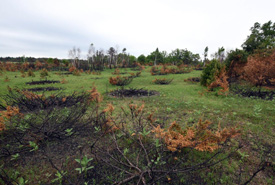
Part of the prescribed burn area at Hazel Bird Nature Reserve (Photo by Robert Britton)
We were well educated during the event about everything from tick protection for us to the purposes and benefits of controlled burns in forested areas. The burns destroy invasive plants and trees and allow the native ones to quickly fill in the gaps. One flowering plant, the yellow pimpernel, has now resurfaced after the seeds had patiently endured a 50-year wait for a better environment.
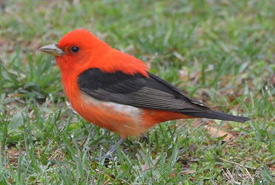
Scarlet tanager (Photo by Andy Reago & Chrissy McClarren, Wikimedia Commons)
The calls of blue jays, woodpeckers and other birds surrounded us. I was delighted to learn of and see for the first time a gorgeous scarlet tanager. The weather seemed like it was verging on a thunderstorm, but as we persisted, it held off.
Planting activities like this taper off late in the spring, but other Conservation Volunteers opportunities for improving and monitoring the habitat will be available at several NCC properties during the summer months prior to some more planting events in the fall.
The volunteers were nature-loving retirees like me, young adults pursuing studies in the environmental field and employees from a corporate-sponsored give-back day. We all got along perfectly. Anyone can enjoy these activities while improving the planet and learning valuable things about our home province’s ecosystem.

